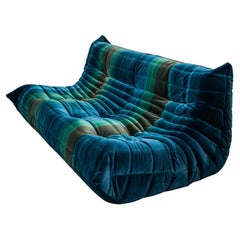Alban Sebastian
Late 20th Century French Modern Lounge Chairs
Fabric, Foam
People Also Browsed
1990s French Modern Sofas
Velvet
Ligne Roset for sale on 1stDibs
With enduring designs like the immensely plush, Pop art–inspired Togo lounge chair and sofa, Ligne Roset has become synonymous with radical luxury furniture. However, when Antoine Roset (1841–93) started the company in 1860 in the small French town of Oussiat, its focus was on wooden umbrella handles.
In 1892, Ligne Roset’s founder expanded with a property in Montagnieu where he set up a wood-processing factory, eventually expanding into manufacturing chairs. After his death, his wife, Marie-Victorine, took over before his son, Emile Roset, began leading the company in the 1910s. It wasn’t until after World War II that Antoine’s grandson, Jean Roset, would recognize the need for furniture in settings like schools, hospitals and retirement homes and take inspiration from Scandinavian modern design for functional pieces made primarily from affordable beech.
Under Jean, Ligne Roset supplied quite a few European institutions with beautiful wood furnishings. In the 1970s, he shifted the company’s focus again, this time looking to domestic and residential markets. Around this time, Jean’s two sons, Pierre and Michel, joined the company. Ligne Roset opened its first store in 1973 with one of the most popular collections being designer Michel Ducaroy’s Togo modular sofa and chairs — classics of contemporary French design that look like oversize bent pillows.
After the success of this initial designer collaboration, Ligne Roset brought on more guest designers over the following decades, including Didier Gomez, Pascal Mourgue, Peter Maly, Pierre Paulin, Inga Sempé and Ronan and Erwan Bouroullec. Paulin’s Elysée sofa and Pumpkin chair — designed in 1971 for Elysée Palace — are among the brand’s most popular pieces.
The brand continues to be run by the Roset family who works on revolutionary furniture in partnership with a variety of collaborators. It has operated in Briord since 1973 where it produces its iconically sleek and innovative pieces.
Find new and vintage Ligne Roset sofas, lounge chairs, tables and other furniture on 1stDibs.
A Close Look at modern Furniture
The late 19th and early 20th centuries saw sweeping social change and major scientific advances — both of which contributed to a new aesthetic: modernism. Rejecting the rigidity of Victorian artistic conventions, modernists sought a new means of expression. References to the natural world and ornate classical embellishments gave way to the sleek simplicity of the Machine Age. Architect Philip Johnson characterized the hallmarks of modernism as “machine-like simplicity, smoothness or surface [and] avoidance of ornament.”
Early practitioners of modernist design include the De Stijl (“The Style”) group, founded in the Netherlands in 1917, and the Bauhaus School, founded two years later in Germany.
Followers of both groups produced sleek, spare designs — many of which became icons of daily life in the 20th century. The modernists rejected both natural and historical references and relied primarily on industrial materials such as metal, glass, plywood, and, later, plastics. While Bauhaus principals Marcel Breuer and Ludwig Mies van der Rohe created furniture from mass-produced, chrome-plated steel, American visionaries like Charles and Ray Eames worked in materials as novel as molded plywood and fiberglass. Today, Breuer’s Wassily chair, Mies van der Rohe’s Barcelona chair — crafted with his romantic partner, designer Lilly Reich — and the Eames lounge chair are emblems of progressive design and vintage originals are prized cornerstones of collections.
It’s difficult to overstate the influence that modernism continues to wield over designers and architects — and equally difficult to overstate how revolutionary it was when it first appeared a century ago. But because modernist furniture designs are so simple, they can blend in seamlessly with just about any type of décor. Don’t overlook them.
Finding the Right lounge-chairs for You
While this specific seating is known to all for its comfort and familiar form, the history of how your favorite antique or vintage lounge chair came to be is slightly more ambiguous.
Although there are rare armchairs dating back as far as the 17th century, some believe that the origins of the first official “lounge chair” are tied to Hungarian modernist designer-architect Marcel Breuer. Sure, Breuer wasn’t exactly reinventing the wheel when he introduced the Wassily lounge chair in 1925, but his seat was indeed revolutionary for its integration of bent tubular steel.
Officially, a lounge chair is simply defined as a “comfortable armchair,” which allows for the shape and material of the furnishings to be extremely diverse. Whether or not chaise longues make the cut for this category is a matter of frequent debate.
The Eames lounge chair, on the other hand, has come to define somewhat of a universal perception of what a lounge chair can be. Introduced in 1956, the Eames lounger (and its partner in cozy, the ottoman) quickly became staples in television shows, prestigious office buildings and sumptuous living rooms. Venerable American mid-century modern designers Charles and Ray Eames intended for it to be the peak of luxury, which they knew meant taking furniture to the next level of style and comfort. Their chair inspired many modern interpretations of the lounge — as well as numerous copies.
On 1stDibs, find a broad range of unique lounge chairs that includes everything from antique Victorian-era seating to vintage mid-century modern lounge chairs by craftspersons such as Hans Wegner to contemporary choices from today’s innovative designers.

